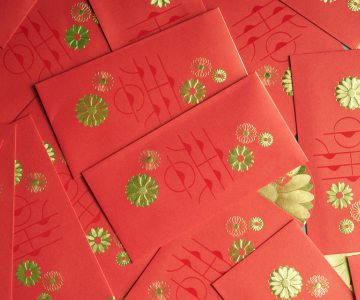Halloween has long been associated with indulgence: every year, supermarkets stock up on spooky editions of our favourite snacks and children go door to door in the hopes of filling up their pockets with chocolate eyeballs and candy pumpkins.
Trick or treating traditions originate from the Celtic custom of ‘guising’ during Samhain, the precursor to modern Halloween. During Samhain, people dressed up in animal heads and skins to ward off evil spirits that were believed to roam the night. While in costume, guisers would perform songs, recite poems, or tell jokes in exchange for food or money.
While these ancient rituals have since evolved, the joy of receiving treats remains. Whether you’re curious about the controversy behind candy corn or in need of inspiration for your next Halloween haul, here are 6 bewitching bites to sink your teeth into this October!
1) Toffee Apples - UK
Visit any UK supermarket during spooky season and you’ll be greeted by rows of glossy red apples on sticks. The name of these popular autumn treats is a little misleading, since most don’t involve any real toffee. The original ‘toffee apple’, or candy apple if you’re in the US, is a whole apple dipped in a bright red sugar glaze: crunchy, sweet, and nostalgically sticky. Although the practice of preserving fruit in honey and sugar dates back centuries, it’s widely believed that the toffee apple was invented by US candy maker William W Kolb in 1908, when, in almost Newtonian fashion, he dropped an apple into a vat of Christmas themed sugar syrup.
Nowadays, there is some debate over what a ‘real’ toffee apple is. While the red glaze still reigns supreme, you can also find apples covered in a soft, creamy caramel, or the most modern incarnation: chocolate and sprinkles. While opinions are divided, most Brits recall fond memories of sticky red fingers next to the warmth of a crackling bonfire.
2) Barmbrack - Ireland
Why visit a psychic when you can simply order a slice of cake? In Ireland, ancient Halloween traditions are all about the future. Barmbrack, or bairín brec in Irish, is a sweet, spiced bread studded with sultanas soaked in tea – and sometimes whiskey, too. During the rest of the year, there’s nothing particularly special about barmbrack, but it’s on Halloween that some tricks are added to the treat. At Samhain, other, ingredients were mixed into the batch: a ring, thimble, coin, piece of cloth, and a pea.
What you find in your slice is said to predict your future: finding a cloth signals poverty or bad luck, while if you bite down on a coin, you’re about to become very wealthy – presumably to pay for the dentistry bills. Predictably, finding a ring means you’re soon to find The One, while a pea suggests you’ll be on the shelf for a little while longer. And what about the thimble? The thimble symbolises spinsterhood: the worst possible fate in Celtic society.
People still enjoy barmbrack today, but bakeries tend to be a little warier about adding metal trinkets into the mix. Still, some traditional bakers continue to sell the original version, thimbles and all.
3) Colcannon - Ireland
Another fortune-telling food is colcannon, from the Irish cal ceannan, meaning white-headed cabbage. Colcannon is a simple but tasty dish of mashed potatoes and cabbage, eaten all-year-round but traditionally served at Halloween. Like barmbrack, it should come with a choke hazard warning, but it’s also associated with some... strange customs. During Samhain, young women would put the first and last spoonful of their colcannon into a sock and hang it on the door. The first man to walk through the door was believed to be their future husband.
4) Candy Corn - USA
Everybody’s heard of candy corn, the iconic American candy – but do you know what it is and where it comes from? The corn-shaped candy is very sweet, with subtle vanilla, honey, and marshmallow flavours and a soft, creamy texture. Originally called ‘chicken feed’, the sweets were invented in the late 1880s by Wunderle candy company, who also invented gummy bears. At the time, candy makers in the US were making buttercream candies inspired by nature, including chestnuts, turnips, and, of course, corn kernels.
While recognisable around the world, the simple candy has sparked a debate in the US over its taste. Some people loathe it, describing it as overly sweet with a strange waxy texture, while others see the kernels as a nostalgic treat enjoyed in moderation.
Despite the controversy, the sweet is so popular that the day before Halloween was nominated ‘National Candy Corn Day’ in the US. Love it or hate it: it’s here to stay.
5) KitKats - Japan
Trick-or-treating might not be a popular pastime in Japan, but throughout the year, small treats are shared in little packages in schools and offices across the country. This
custom, rooted in Japan’s unique omiyage – or gift giving – culture, also extends to Halloween, when office workers find Halloween themed chocolates on their desks, including KitKats, from coworkers.
While KitKats might not sound like an exciting treat, Japan’s are a little different. The company seems unable to take a break from inventing new flavours. Back in the early 2000s, KitKat capitalised on Japan’s omiyage culture by creating hundreds of unique flavours, some exclusive to specific cities or regions. From Kyoto’s deep green matcha to Tochigi’s strawberry flavour, there are now hundreds to choose from.
Every year, KitKat releases a special Halloween-themed flavour, complete with kawaii ghosts and pumpkins on the packaging. Past flavours have included apple pie, sweet potato, and caramel pudding.
6) Soul Cakes - UK
Back in the days of All Hallows’ Eve, people would go ‘souling’, another early form of trick-or-treating. Instead of asking for candy, though, soulers would go door-to-door offering prayers for families’ deceased relatives in exchange for soul cakes - small shortbread biscuits baked with spices and filled with dried fruit. Each soul cake symbolised the release of a soul from purgatory.
Soul cakes might be a thing of the past, but traditional bakeries still sell them during Halloween. In fact, last year, English heritage sites invited the public to go souling at 13 historic locations, from half-ruined castles to medieval priories. Lucky soulers were treated to soul cakes, though praying for trapped souls in purgatory was optional this time.
Even if your trick-or-treating days are over, why not indulge in a trip to Samhain’s roots? Our English Centres in London and Dublin are designed with immersion in mind, combining exceptional classroom teaching with cultural excursions to world-class destinations.



